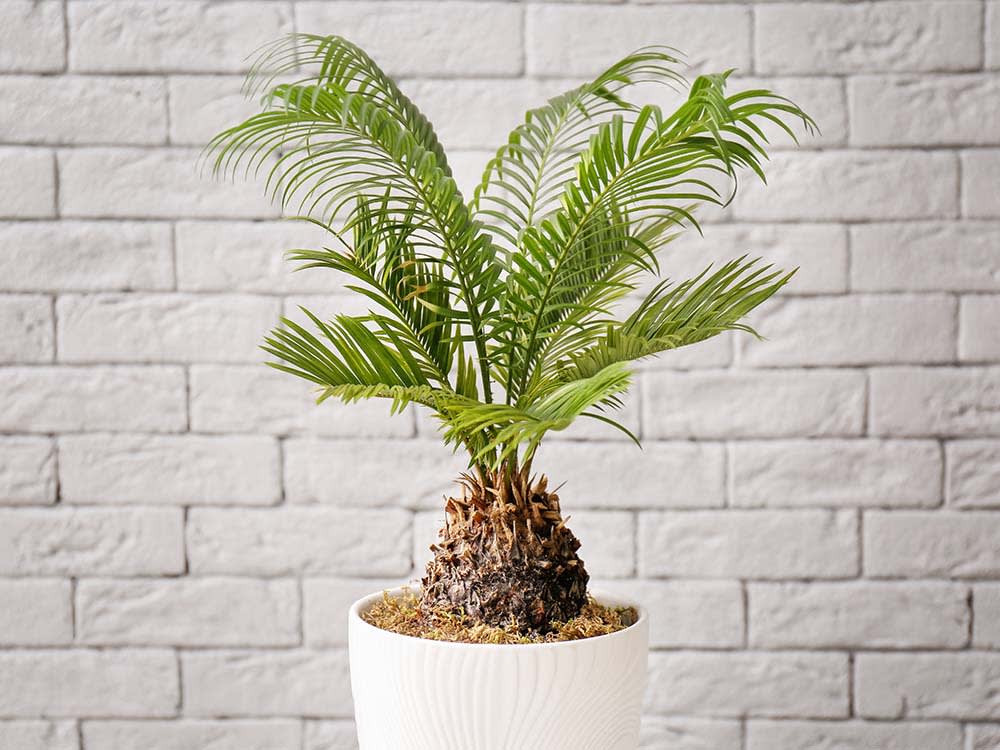Two Georgia Dogs Died After Consuming the Toxic Sago Palm
It looks cute, but this plant is incredibly deadly to dogs. Here’s everything you need to know.

Share Article
Last month, one dog mom in Savannah, Georgia, noticed that her pups were sick — seemingly out of nowhere, they had become extremely lethargic and begun to vomit. “I was terrified. I was so scared. Because they don’t act like that at all. They are usually happy and playful. But, I went to the backyard and one dog is lying curled up and the other is stuck on the concrete unable to move,” Erin Sensing, the pet parent of the dogs, told WSAVopens in new tab.
Within hours, two of her dogs had tragically died. The culprit? Sago palm, a common house and yard plant that is extremely dangerous for dogs. Many people are unaware that the sago palm is toxic; even ingesting a small amount can cause a pup to get seriously sick. Here’s everything you need to know.
What are sago palms?
Sago palms are very popular indoor and outdoor plants sold in big box stores. Despite the name, they’re actually not palm trees (they just look like them). Sago palms are also known as Coontie Palm, Cardboard Palm, Kind Sago, Japanese Sago Palm, Zamias, and may even be unmarked. The sago palm is part of the cycad seed plant family and contains the toxin cycasin. Even very young sago palms are toxic enough to cause death in dogs.
Contrary to popular belief, all parts of both male and female plants are toxic, with the seeds being the most lethal component of the sago palm. The reddish-orange seeds are round to oblong in shape and can be a little bigger than a golf ball in mature plants. Unfortunately, many dogs seem to enjoy chewing on these bitter seeds, which leads to toxicity.

Are sago palms toxic for dogs?
Many people are unaware that the plant is deadly to pets. I’ve even heard talk of people throwing the seeds like a ball for their dog, completely unaware of the deadly dangers. And even if they have heard of the toxic effects, they don’t realize that the plant they are purchasing is actually a sago palm. Why is this?
The plants are becoming increasingly popular in all areas of the country in commercial and residential landscaping, and are often sold as unmarked potted plants in stores such as Target and Home Depot. They are simply labeled as a “palm tree,” without any warning label, and people are not aware that they are bringing home a potentially lethal plant.
Over the past five years, the ASPCA Animal Poison Control Centeropens in new tab has seen an increase in sago palm toxicities by 200 percent, and according to their data, 50 to 75 percent of cases result in the death of the pet. This number includes pets that are euthanized due to the cost of care. On a slightly brighter note, 68 percent of those pets that are treated early are reported to survive.
What are the symptoms of sago palm poisoning?
Dogs who have ingested any part of the sago palm plant begin vomiting as early as 15 minutes after ingestion and may continue up to a couple hours after ingestion. Vomiting can be accompanied by diarrhea, depression, and lack of appetite. Liver failure generally occurs within 24 to 36 hours following ingestion, and in most cases, intensive treatment is necessary.
Here are all of the signs and symptoms to lookout for:
Drooling
Vomiting
Diarrhea
Depression
Lack of appetite
Lethargy
Ataxia
Seizures
Tremors
Liver failure
How is sago palm poisoning treated?
Early treatment saves lives, so take your dog to the vet ASAP if you suspect your dog ingested sago palm. If it has been four to six hours since your dog ingested it, your veterinarian will attempt to induce vomiting, as well as give your dog charcoal to help absorb the toxin. Intravenous fluids for 72 hours, medications to help support liver function, and possibly the transfusion of blood products are needed. Your vet will monitor your pup’s liver values to determine their recovery progress.
How to avoid sago palm poisoning
If you share your home or yard with a sago palm, now is the time to dig it up and dump it in the garbage. Make sure you are disposing of it in your “actual” garbage, and not your compost or yard waste bin, as these contents are often mulched and repurposed, putting the palm back into the environment where other pets can be exposed. See our list of five common house plants that are toxic to dogs so you know what other plants to watch out for. And remember: If you think your dog may have eaten any part of a sago palm, please seek veterinary care immediately.

Dr. Shea Cox, DVM, CVPP, CHPV
Dr. Shea Cox is the founder of BluePearl Pet Hospice and is a global leader in animal hospice and palliative care. With a focus on technology, innovation and education, her efforts are changing the end-of-life landscape in veterinary medicine.
Related articles
![Young Woman Working From Home with Her Dog]()
The 10 Best Non-Toxic House Plants for Dogs
Brb, running out to buy air plants and succulents.
![Basset Hound sitting in a bright sunny apartment beside a potted palm tree]()
Garden Variety: Plants Safe for Our Pups
Boutique NYC nursery The Sill gives us the dirt on dog-friendly plants.
![Plant Kween standing in a greenhouse space wearing brightly colored pants and a beige corset top smiling in a carefree way]()
The Plant Kween Has Spoken!
We’ve got the fabulous gardener’s take on pet-friendly plants.
![Dog-friendly backyard, dog playing in the sprinkler]()
6 Ways to Make Your Yard a Canine Xanadu
Kiddie pools aren’t just for kids!
Are Snake Plants Toxic to My Dog?
Just get a new dog? Might be time to find a new home for your snake plant.






